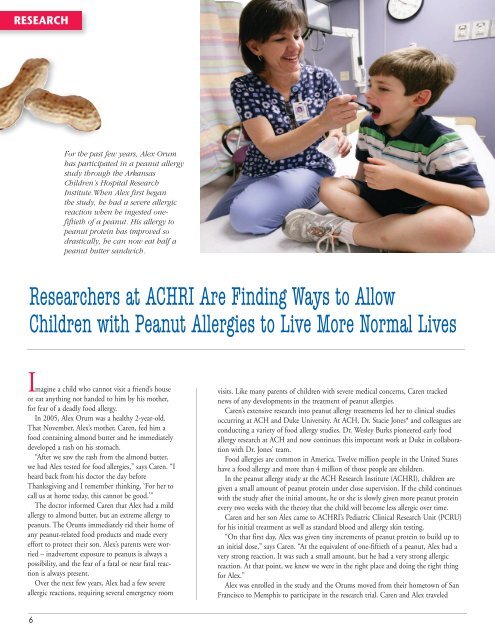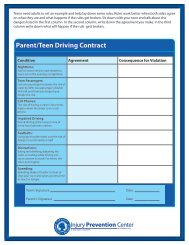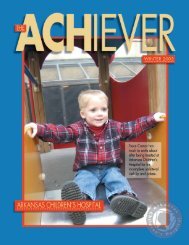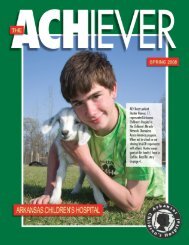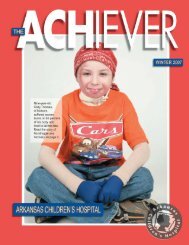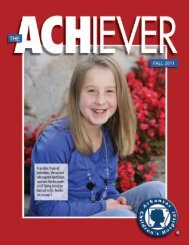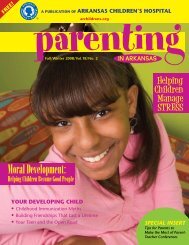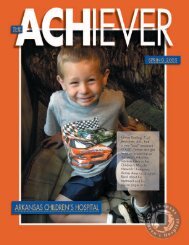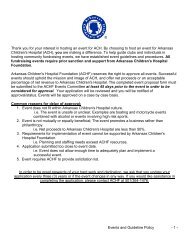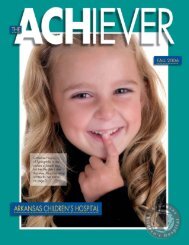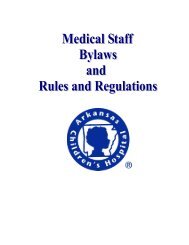Spring 2010 - Arkansas Children's Hospital
Spring 2010 - Arkansas Children's Hospital
Spring 2010 - Arkansas Children's Hospital
You also want an ePaper? Increase the reach of your titles
YUMPU automatically turns print PDFs into web optimized ePapers that Google loves.
RESEARCH<br />
For the past few years, Alex Orum<br />
has participated in a peanut allergy<br />
study through the <strong>Arkansas</strong><br />
Children’s <strong>Hospital</strong> Research<br />
Institute.When Alex first began<br />
the study, he had a severe allergic<br />
reaction when he ingested onefiftieth<br />
of a peanut. His allergy to<br />
peanut protein has improved so<br />
drastically, he can now eat half a<br />
peanut butter sandwich.<br />
Researchers at ACHRI Are Finding Ways to Allow<br />
Children with Peanut Allergies to Live More Normal Lives<br />
Imagine a child who cannot visit a friend’s house<br />
or eat anything not handed to him by his mother,<br />
for fear of a deadly food allergy.<br />
In 2005, Alex Orum was a healthy 2-year-old.<br />
That November, Alex’s mother, Caren, fed him a<br />
food containing almond butter and he immediately<br />
developed a rash on his stomach.<br />
“After we saw the rash from the almond butter,<br />
we had Alex tested for food allergies,” says Caren. “I<br />
heard back from his doctor the day before<br />
Thanksgiving and I remember thinking, ‘For her to<br />
call us at home today, this cannot be good.’”<br />
The doctor informed Caren that Alex had a mild<br />
allergy to almond butter, but an extreme allergy to<br />
peanuts. The Orums immediately rid their home of<br />
any peanut-related food products and made every<br />
effort to protect their son. Alex’s parents were worried<br />
– inadvertent exposure to peanuts is always a<br />
possibility, and the fear of a fatal or near fatal reaction<br />
is always present.<br />
Over the next few years, Alex had a few severe<br />
allergic reactions, requiring several emergency room<br />
visits. Like many parents of children with severe medical concerns, Caren tracked<br />
news of any developments in the treatment of peanut allergies.<br />
Caren’s extensive research into peanut allergy treatments led her to clinical studies<br />
occurring at ACH and Duke University. At ACH, Dr. Stacie Jones* and colleagues are<br />
conducting a variety of food allergy studies. Dr. Wesley Burks pioneered early food<br />
allergy research at ACH and now continues this important work at Duke in collaboration<br />
with Dr. Jones’ team.<br />
Food allergies are common in America. Twelve million people in the United States<br />
have a food allergy and more than 4 million of those people are children.<br />
In the peanut allergy study at the ACH Research Institute (ACHRI), children are<br />
given a small amount of peanut protein under close supervision. If the child continues<br />
with the study after the initial amount, he or she is slowly given more peanut protein<br />
every two weeks with the theory that the child will become less allergic over time.<br />
Caren and her son Alex came to ACHRI’s Pediatric Clinical Research Unit (PCRU)<br />
for his initial treatment as well as standard blood and allergy skin testing.<br />
“On that first day, Alex was given tiny increments of peanut protein to build up to<br />
an initial dose,” says Caren. “At the equivalent of one-fiftieth of a peanut, Alex had a<br />
very strong reaction. It was such a small amount, but he had a very strong allergic<br />
reaction. At that point, we knew we were in the right place and doing the right thing<br />
for Alex.”<br />
Alex was enrolled in the study and the Orums moved from their hometown of San<br />
Francisco to Memphis to participate in the research trial. Caren and Alex traveled<br />
6


